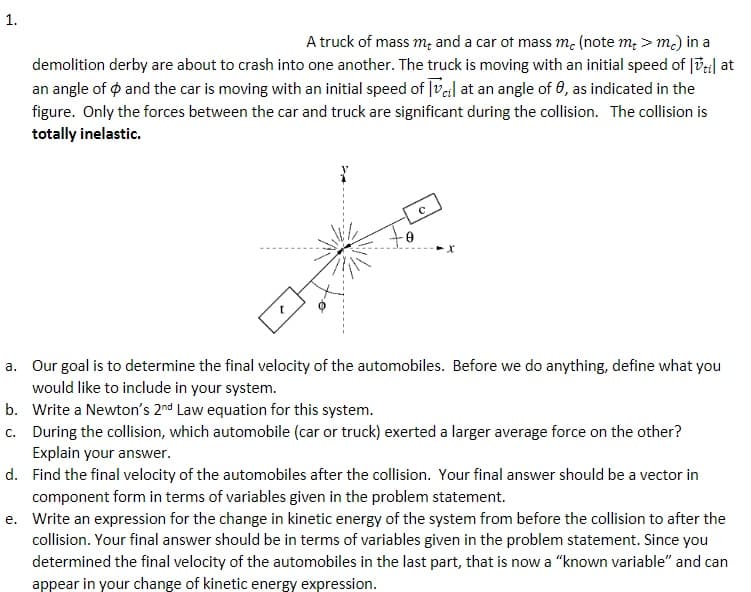1. A truck of mass m, and a car ot mass m. (note m; > m.) in a demolition derby are about to crash into one another. The truck is moving with an initial speed of Jv| at an angle of o and the car is moving with an initial speed of Jvel at an angle of 0, as indicated in the figure. Only the forces between the car and truck are significant during the collision. The collision is totally inelastic. a. Our goal is to determine the final velocity of the automobiles. Before we do anything, define what you would like to include in your system. b. Write a Newton's 2nd Law equation for this system. c. During the collision, which automobile (car or truck) exerted a larger average force on the other? Explain your answer. d. Find the final velocity of the automobiles after the collision. Your final answer should be a vector in component form in terms of variables given in the problem statement. e. Write an expression for the change in kinetic energy of the system from before the collision to after the collision. Your final answer should be in terms of variables given in the problem statement. Since you determined the final velocity of the automobiles in the last part, that is now a "known variable" and can appear in your change of kinetic energy expression.
1. A truck of mass m, and a car ot mass m. (note m; > m.) in a demolition derby are about to crash into one another. The truck is moving with an initial speed of Jv| at an angle of o and the car is moving with an initial speed of Jvel at an angle of 0, as indicated in the figure. Only the forces between the car and truck are significant during the collision. The collision is totally inelastic. a. Our goal is to determine the final velocity of the automobiles. Before we do anything, define what you would like to include in your system. b. Write a Newton's 2nd Law equation for this system. c. During the collision, which automobile (car or truck) exerted a larger average force on the other? Explain your answer. d. Find the final velocity of the automobiles after the collision. Your final answer should be a vector in component form in terms of variables given in the problem statement. e. Write an expression for the change in kinetic energy of the system from before the collision to after the collision. Your final answer should be in terms of variables given in the problem statement. Since you determined the final velocity of the automobiles in the last part, that is now a "known variable" and can appear in your change of kinetic energy expression.
Related questions
Question
d and e

Transcribed Image Text:1.
A truck of mass m, and a car ot mass m. (note m, > m.) in a
demolition derby are about to crash into one another. The truck is moving with an initial speed of |vi| at
an angle of o and the car is moving with an initial speed of Jveil at an angle of 0, as indicated in the
figure. Only the forces between the car and truck are significant during the collision. The collision is
totally inelastic.
a. Our goal is to determine the final velocity of the automobiles. Before we do anything, define what you
would like to include in your system.
b. Write a Newton's 2nd Law equation for this system.
c. During the collision, which automobile (car or truck) exerted a larger average force on the other?
Explain your answer.
d. Find the final velocity of the automobiles after the collision. Your final answer should be a vector in
component form in terms of variables given in the problem statement.
e. Write an expression for the change in kinetic energy of the system from before the collision to after the
collision. Your final answer should be in terms of variables given in the problem statement. Since you
determined the final velocity of the automobiles in the last part, that is now a "known variable" and can
appear in your change of kinetic energy expression.
Expert Solution
This question has been solved!
Explore an expertly crafted, step-by-step solution for a thorough understanding of key concepts.
This is a popular solution!
Trending now
This is a popular solution!
Step by step
Solved in 2 steps
